 |
October 1999 - Report
LAYER ONE - The Internet Infrastructure Indicator
LAYER TWO - The Internet Applications Infrastructure Indicator
LAYER THREE - The Internet Intermediary Indicator
LAYER FOUR - The Internet Commerce Indicator
The Faces of the Internet Economy
Due to the complexity and inter-relatedness of the companies that contribute to the Internet Economy, a
classification system was developed to allow for associated revenues and employees to belong to distinct
segments. The most logical approach for this classification system was to break apart the Internet economy into
layers based upon the unique elements necessary to facilitate the ultimate revenue producer on the Internet,
sales transactions. A more detailed description of how we defined and measured the Internet Economy is
included in a later section of the report.
LAYER ONE - The Internet Infrastructure Indicator
(Back to top)
The Internet Infrastructure layer consists of the telecommunications companies, Internet Service Providers, Internet
backbone carriers, “last mile” access companies and manufacturers of end-user networking equipment all of which
is a prerequisite for the Web and the proliferation of Internet based electronic commerce.

-
The Internet Infrastructure Layer generated over $40 billion in revenue for the first quarter of 1999. Revenue
for Internet Infrastructure companies grew 50 percent over Q1 1998. While this was strong growth, it was
somewhat less than the other three layers of the Internet Economy.

-
For the first quarter of 1999, Internet-related employees in the Infrastructure layer grew 39 percent from
Q1 1998.
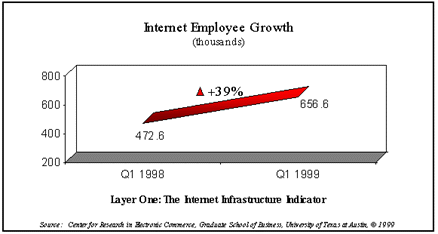
-
While Q1 1999 witnessed consolidation across many industries, most notably in telecommunications, the research
showed relatively less consolidation for the Internet Infrastructure companies. The top ten infrastrucu re companies
re p resent 44 percent of the total layer one revenue, down from 50 percent in Q1 1998. Eight of the top ten
Internet Infrastructure companies are computer hardware providers, and two are ISP’s .
- Revenue per employee for layer one companies in Q1 1999 is $61,136, representing an 8 percent increase over
Q1 1998. Of all four layers of the Internet Economy, Internet Infrastructure companies have the highest
revenue per employee, a finding consistent with the previous wave of research.
- Some of the largest Internet Infrastructure companies are participating in multiple layers of the Internet
Economy, either generating significant E-commerce revenues or providing layer two products or services.
Faces of the Internet Economy
 Freei.Net Freei.Net
Steve Bourg, chief technical officer
www.freei.net
(Back to top)
Freei.Net is one of the first free Internet Service Providers (ISP), offering Internet access in exchange for
demographic information used to target banner ads displayed during on-line sessions. Every 12 seconds, Freei.Net
acquires a new subscriber, and 17 percent of those subscribers are new to the Internet. By opening the Internet
economy to those unwilling or unable to pay the monthly fees of a traditional ISP, Freei.Net is expanding the E-commerce
customer base. Every 12 seconds, Freei.Net
acquires a new subscriber, and 17 percent of those subscribers are new to the Internet. By opening the Internet
economy to those unwilling or unable to pay the monthly fees of a traditional ISP, Freei.Net is expanding the E-commerce
customer base.
“Freei.Net is not just increasing Internet access and we’re acting as a catalyst for E-business,” said Steve Bourg, chief
technical officer of Freei.Net. “There are so many things we could do on the Internet if everyone had access. We
think free Internet access is going to be a big part of bringing everyone online and opening the doors for new
technological development.”
LAYER TWO - The Internet Applications Infrastructure Indicator
(Back to top)
The Internet Applications Infrastructure involves software products and services necessary to facilitate Web
transactions and transaction intermediaries. In addition to the software products that help facilitate Web
transactions, this layer of the Internet Economy includes the consultants and service companies that design, build
and maintain all types of Web sites, from portals to full E-commerce sites.

As the Internet Economy continues to grow and the network infrastructure continues to provide increased
bandwidth, we expect to see continued strong growth in the development of applications such as video and audio
streaming technologies and other Web-based applications.
- The Internet Applications Infrastructure layer generated over $20 billion in revenue for the first quarter of
1999. Revenue for Applications Infrastructure companies in Q1 1999 grew 61 percent over Q1 1998. Of the
four layers, this layer grew at the second fastest pace.
-
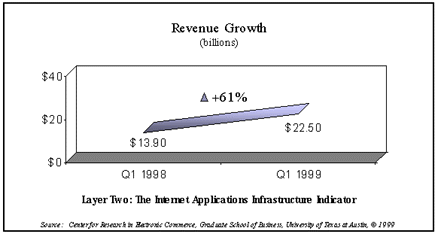
-
For the first quarter of 1999, Internet-related employees in the Applications Infra s t r u c t u re layer grew 38 perc e n t
year-over-year to 563,124 from a total of 407,858 Internet-related employees in the first quarter of 1998.
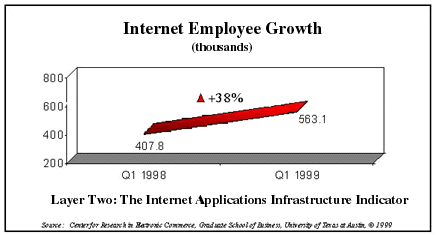
- The companies with most growth in the Applications Infrastructure layer were Internet consulting and Web
applications software firms, reflecting movement of the Internet economy to Web development, applications
service providers who are meeting the needs of companies aggressively moving to an E-business strategy.
- Findings from this layer are consistent with an overall trend that IT services revenue is one of the strongest
categories of IT spending growth among worldwide corporations. The Internet is no exception - online technical
support, software for Web-development and Internet consulting services are other key drivers of this trend.
- Revenue per employee grew by 17 percent to $39,933 from Q1 1998 to Q1 1999, lower than infrastructure or
E-commerce companies. This is not a surprising finding since most of the Internet solutions and Web/E-commerce
consulting is in this layer and service companies have a much more people-intensive business model
than those of any other layer.
- The top 10 Applications Infrastructure companies were made up exclusively of America’s largest software and
consulting companies. In terms of quarterly revenue for the Applications Infrastructure layer, the top 10
players represented 43 percent of the total in Q1 1999, up from 41 percent in Q1 1998.
Faces of the Internet Economy
 eCode.com eCode.com
Laurent Gharda, chief operating officer
www.ecode.com
(Back to top)
eCode, a startup based in Sunnyvale, CA, recognized a need to have a single repository of contact information on
the Internet that would always be up to date and readily available.  Today, people are moving more frequently, have
numerous contact numbers and email addresses, and are constantly having to update personal information. eCode
has the answer - Universal Internet Identity. eCode envisions a world where people will never have to give out new
contact information again. Today, people are moving more frequently, have
numerous contact numbers and email addresses, and are constantly having to update personal information. eCode
has the answer - Universal Internet Identity. eCode envisions a world where people will never have to give out new
contact information again.
“Before the Internet, society was faced with an overwhelming level of technological complexity that didn’t
necessarily reduce the amount of effort required to get anything done,” said Laurent Gharda, CEO of ecode.com. “By
leveraging the Internet, eCode is fostering better communications between individuals and organizations, improving
people’s lives. Our vision for eCode is huge - we see a world where our solutions are so prevalent that our great,
great grandchildren will trace their family trees by eCode.”
LAYER THREE - The Internet Intermediary Indicator
(Back to top)
When looking at businesses conducting transactions on the Web, it was recognized that there was a class of
business that did not generate transaction-related revenues in the same way as companies in the Internet
Commerce layer (layer four). Therefore, it was determined that a classification layer would be added for these types
of companies and that layer is called the Internet Intermediary Indicator.
There is a distinct type of company that operates in layer three, one that is predominantly an Internet pure-play.
While not directly generating revenues from transactions, their Web-based business generates revenues through
advertising, membership subscription fees, and commissions. Many of the layer three companies are purely Web
content providers while others are market makers or market intermediaries. This is an important group of companies
that is likely to have a significant impact over time on the efficiency and performance of electronic markets.

-
For the first quarter of 1999, revenues for Internet Intermediaries increased 52 percent to $16.7 billion from
$10.9 billion in the first quarter of 1998.

- Internet Intermediary companies realized 25 percent growth in Internet-related employees in Q1 1999, and at
current growth rates will have more than a half million employees by the end of 1999.
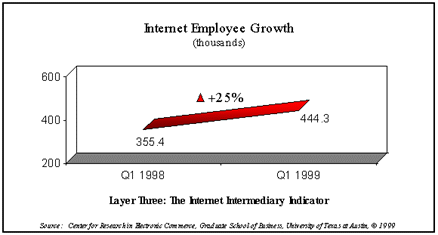
- Internet Intermediary companies with the most dramatic growth were in electronic brokerage, online travel,
portals, Internet auctions and Internet advertisers, while other intermediaries grew at relatively slower rates
among companies in this layer.
- While revenue per employee grew to $37,510, up 21 percent from Q1 1998 levels, it is still lower than the
other three layers.
- The top 10 Internet Intermediaries held only 23 percent of the total Layer 3 revenue in Q1 1999, up from 20
percent in Q1 1998. There is still less concentration of top players in this category than in the other 3 layers.
The top 10 firms represent a varied mix including resellers, conglomerates, media, brokerage and portals.
Faces of the Internet Economy

Ecoverage
David Riker, president and chief executive officer
www.ecoverage.com
(Back to top)
According to Forrester Research, online sales for the insurance industry are expected to grow to $4.1 billion in 2003,
up from $1.1 billion in 2001. One of the companies attempting to grab a share of the estimated $60 billion
insurance industry is eCoverage, a startup based in San Francisco. eCoverage is the first and only Internet-based
company to service the insurance customer from quote to claim, simplifying the entire insurance process for the
consumer. a startup based in San Francisco. eCoverage is the first and only Internet-based
company to service the insurance customer from quote to claim, simplifying the entire insurance process for the
consumer.
“We have an opportunity to leverage the advances of the Internet to create a dramatic change in the way business
is done,” said eCoverage CEO David Riker. “By giving people the tools to understand the entire insurance process,
we’ve eliminated a process that was previously torture on the consumer. The Internet has created an entirely new
economy - one where companies can leverage technology to create better products and processes, giving consumers
immediate access to better products.”
LAYER FOUR - The Internet Commerce Indicator
(Back to top)
The companies that are included in layer four are only those companies that are conducting Web-based commerce
transactions. While many other studies of E-commerce have included intermediary-type companies such as
VerticalNet or E-Bay, we included those companies in layer three.
The companies that we have included in layer four cross a wide variety of vertical industries. In addition, the
commerce layer contains quite a few ‘mom and pop’ shops generating a decent revenue stream.
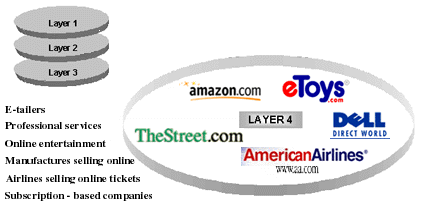
- Electronic commerce is exploding among the U.S.-based companies studied. Quarterly Internet revenue among
companies in this layer grew 127 percent from Q1 1998 to Q1 1999, by far the fastest growing layer of the
Internet Economy.
- Q1 1999 revenues were $37.5 billion, which projects to over $170 billion annualized for 1999. This estimate
alone is higher than some other studies have estimated for 1999 (e.g., IDC, Forrester, Morgan Stanley). Adding
in the intermediary layer, which is included in the E-commerce estimates of other research studies, the total
estimate is close to $250 billion for 1999.
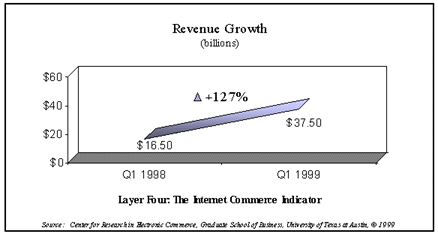
- Much of the investment in human capital has been in this layer where Internet employees grew 78 percent
from Q1 1998 to Q1 1999, phenomenal growth, but still less than the revenue growth, meaning that efficiency
of this layer is increasing as commerce systems get in place and have run for a longer period of time.
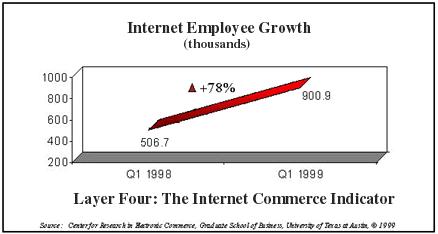
- Electronic commerce growth was very strong among e-tailers and new entrants into Internet commerce, such
as banks or financial services firms. The greatest portion of Layer 4 revenue is still concentrated among
computer companies, who have the longest and most established systems in this area.
- The top 10 firms in E-commerce re p resent 32 percent of quarterly E-commerce revenue in Q1 1999, up from 27
p e rcent in Q1 1998 - it is interesting that no “pure play” Internet companies are in the top 10 revenue producers
in this layer.
Faces of the Internet Economy
 Stacia New York Stacia New York
Stacy Johnson, owner and designer
www.stacianewyork.com
(Back to top)
When Stacy Johnson opened her boutique-clothing store last year in Brooklyn, her goal was to attract customers
from Manhattan and the surrounding area. Since establishing an online presence this summer, Johnson has seen
orders flow in from around the world. Stacia NewYork is one example of the ways the Internet is  allowing
designers, craftsmen, and artisans to realize the dream of living off their art. allowing
designers, craftsmen, and artisans to realize the dream of living off their art.
The 29 year-old designer opened her boutique on Davis Street in Brooklyn last November after five years of working
in the fashion industry. Following six successful months she started to envision ways to extend her sales and brand
to a larger audience without sacrificing the retail structure of her existing business.
The solution was the creation of Stacianewyork.com. “The Internet is the perfect vehicle for a company of this size
to reach a wider audience,” said Johnson. “The costs are minimal, you don’t have to worry about additional shelf
space, and you don’t have to hire additional people to make it happen.”
Stacia NewYork offers clothes and accessories targeted at 20–40 year-old female professionals. Johnson designs the
patterns and clothes herself and so far hasn’t had to contract out any of her work. But the Internet might change
that very quickly. Stacianewyork.com has been online for only two months but already accounts for over fives
percent of overall sales. “The potential for Internet-generated sales is enormous for a boutique clothing company
like mine,” said Johnson.
|




 Every 12 seconds, Freei.Net
acquires a new subscriber, and 17 percent of those subscribers are new to the Internet. By opening the Internet
economy to those unwilling or unable to pay the monthly fees of a traditional ISP, Freei.Net is expanding the E-commerce
customer base.
Every 12 seconds, Freei.Net
acquires a new subscriber, and 17 percent of those subscribers are new to the Internet. By opening the Internet
economy to those unwilling or unable to pay the monthly fees of a traditional ISP, Freei.Net is expanding the E-commerce
customer base.


 Today, people are moving more frequently, have
numerous contact numbers and email addresses, and are constantly having to update personal information. eCode
has the answer - Universal Internet Identity. eCode envisions a world where people will never have to give out new
contact information again.
Today, people are moving more frequently, have
numerous contact numbers and email addresses, and are constantly having to update personal information. eCode
has the answer - Universal Internet Identity. eCode envisions a world where people will never have to give out new
contact information again.



 allowing
designers, craftsmen, and artisans to realize the dream of living off their art.
allowing
designers, craftsmen, and artisans to realize the dream of living off their art.